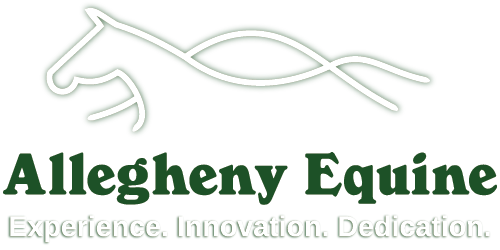Equine Imaging
Equine Imaging has become an integral part of equine veterinary medicine. Lameness exams routinely require radiographs and ultrasounds of the affected limb. Advanced medical diagnostics frequently involve endoscopy or ultrasound to evaluate organ systems and monitor response to therapies. At Allegheny Equine we have multiple systems that are able to go out into the field for on-the-farm evaluation or in-the-clinic advanced techniques.


Digital Radiography
From long bones and joints to necks, backs and skulls radiographs provide important information on the structure and integrity of the skeleton. Equipped with three digital radiograph systems, our veterinarians are able to provide instant viewing of high quality radiographs (x-rays) at the time of the evaluation. Radiography aid in the diagnosis of numerous issues such as arthritis, fractures, bone chips, sinus infections and tooth root abscesses to name a few. Radiographs called “farrier films, ” are views of the horse’s feet that are taken when working with a farrier on a patient who is having issues such as lamanitis, hoof imbalance or navicular syndrome. During a prepurchase exam radiographs are frequently taken to evaluate the horse’s limbs for the buyer.
All the images taken by our veterinarians are kept at an off-site digital storage and can be accessed remotely or emailed to a client at any time.
Digital Ultrasound
Ultrasound is used to evaluate soft tissue structures such as tendons, ligaments, internal organs and reproductive tracts. Allegheny Equine has multiple machines which allow us to perform specialized ultrasounds not just for lameness and reproduction but of the abdomen, thorax, heart, and even eyes. Ultrasound provides a window into the horse allowing the veterinarian to evaluate the injury or change in the soft tissue. The area can be reevaluated, as treatment is initiated, to monitor change or healing over time. Ultrasound guided injection or aspirates allows the veterinarian to visualize the area they are working on while doing the procedure.
Endoscopy
Endoscopy is used to visualize internal structures such as the upper airway, gutteral pouches, stomach and bladder. The endoscope is a long flexible tube attached to a light and camera. Our video endoscopy system allows the client to watch the endoscopy with the veterinarian live. Samples can be taken through the scope . Common problems such as foreign bodies and gastric ulcers can be identified with this technology. Allegheny Equine has both a 1 meter and 3 meter scope for evaluation of these structures.
